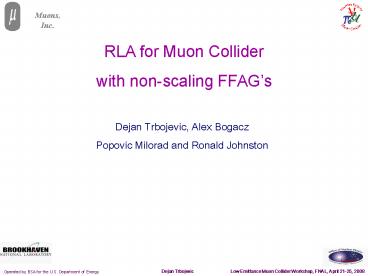Berkeley Lab Generic Presentation - PowerPoint PPT Presentation
1 / 26
Title:
Berkeley Lab Generic Presentation
Description:
... times in muon energy by either a race track or dog-bone acceleration with a ... Design a chicane to adjust the time of flight for different energy passes. ... – PowerPoint PPT presentation
Number of Views:23
Avg rating:3.0/5.0
Title: Berkeley Lab Generic Presentation
1
RLA for Muon Collider with non-scaling FFAGs
Dejan Trbojevic, Alex Bogacz Popovic Milorad and
Ronald Johnston
2
RLA for Muons
- Introduction
- Present design of the muon RLAs you have heard
the talk an hour ago - What is the non-scaling FFAG?
- Goals
- Try to make four or five times in muon energy by
either a race track or dog-bone acceleration with
a single arc (2.5-10 GeV or 10-40 GeV). - New concept linac with fixed betatron function
during all energy passes. - Match the betatron and dispersion functions from
the arc to the linac. - Design a chicane to adjust the time of flight for
different energy passes.
3
Racetrack vs Dogbone RLA (both m and m-
species )
From Alex Bogacz presentation at the previous
LEMC
DE
- better orbit separation at linacs end energy
difference between consecutive passes (2DE) - allows both charges to traverse the Linac in the
same direction (more uniform focusing profile - the droplets can be reduced in size according to
the required energy - both charge signs can be made to follow a
Figure-8 path (suppression of depolarization
effects) Chuck Ankenbrandt
4
FODO vs Triplet focusing - flat focusing' linac
profile
Bob Palmer
From Alex Bogacz presentation at the previous
LEMC
Triplet
1-pass, 3-5 GeV
256.82 meters
phase adv. drops much faster in the horizontal
plane
5
What is the non-scaling FFAG?
- Orbit offsets are proportional to the dispersion
function - Dx Dx dp/p
- To reduce the orbit offsets to -6 cm range, for
momentum range of dp/p - 60 the dispersion
function Dx has to be of the order of - Dx 6 cm / 0.6 10 cm
- The size and dependence of the dispersion
function is best presented in the normalized
space and by the H function - ? Dx /??x and ? Dx ??x ?x Dx ??x
- with H H ?2 ?2
6
Basic properties of the NS-FFAG
A . Particle orbits
B. Lattice
7
Basic properties of the NS-FFAG
Muon acceleration
- Concept introduced 1999 at Montauk meeting
Trbojevic, Courant, Garren) using the light
source lattice with small emittance minimized H
function
- Extremely strong
- focusing with small
- dispersion function.
- large energy acceptance.
- - tunes variation
- very small orbit offsets
- - small magnets
8
Design of the arcs from the densely populated
FODO cells for the 2.5 -gt 10 GeV muons
N142 cells L1.9 m LBD0.9 m LQF0.6 m For the
dp/p-60 BBD1.64 T BQF -1.09 T GF20.8
T/m GD-10.2 T/m For the dp/p 0, -75 BBD3.62
T BQF -2.98 T GF37.0 T/m GD-23.0 T/m
r42.94 m
85.9 m
9
Design of the arcs from the densely populated
FODO cells for the 2.5 -gt 10 GeV muons
N142 cells L1.9 m LBD0.9 m LQF0.6 m For the
dp/p-60 BBD1.64 T BQF -1.09 T GF20.8
T/m GD-10.2 T/m For the dp/p 0, -75 BBD3.62
T BQF -2.98 T GF37.0 T/m GD-23.0 T/m
r42.94 m
85.9 m
10
Arc cells for two different lattices
FODO cell for the central energy at the top 10 GeV
FODO cell for the -60
1.9 m
x max81 mm
0.3 m
x min -16 mm
0.9 m
x max62 mm
11
Matching cell arc to linac
The matching cell length is L3 1.9 m 5.7 m
12
Matching cell with arcs without linac
Orbits from 2.5 10 GeV Through the matching
cells and arcs
13
Time of flight correction preliminary chicanes
design
Details of the orbits Through the matching cells
14
New concept of the linac triplets with cavities
20 cavities each 25 MV/m 0.250 GeV per one
pass
2q
- q
-q
10 GeV
2.5 GeV
7.2 mm
15
New concept of the linac Betatron Function
dependence on energy
16
New concept of the linac Tunes per Linac cell
17
New concept of the linac triplets with cavities
Cavity
Cavity
2q
-q
-q
7.2 mm
18
Matching cell with linac arc to linac
Orbits magnified 100 times From 2.5 GeV- 10GeV
19
20 cells linac
20
New Concept Multipass Linac with racetrack FFAG
Chicane
20 Cavities
Chicane
Non-scaling FFAG arc
Non-scaling FFAG arc
Chicane
Chicane
20 Cavities
21
New Concept Multipass Linac with fixed betatron
functions
Longer linac
22
New Concept Multipass Linac with fixed betatron
functions
Details of the orbits with Chicanes
23
Path length difference from the arc cell
24
Details of the Chicane
CAVITY
TRIPLET
25
Details of the chicane calculations
Lo /Lcos q
26
Conclusions
- It looks like a combination of the non-scaling
FFAG with linac is possible this could reduce
present number of arcs. - New concept of the multiple pass linac with
stable betatron function has been introduced for
the first time!! - Time of flight adjustments is necessary due to
0.6 m delay for the lowest energy pass through
the arc. A details of chicane design has to be
studied. - Initial matching between the two arcs and linac
could be improved. - The simulation of acceleration with many
particles is already set-up by the PTC
(Polymorhic Tracking Code). - There is a possibility to increass energy gain to
5 times as it had been done in the eRHIC example. - Thanks to Muon Inc. for the support































